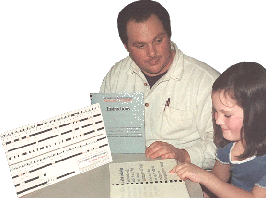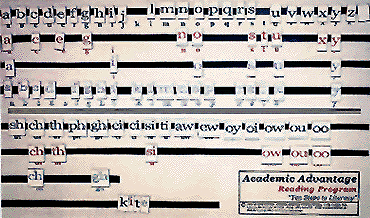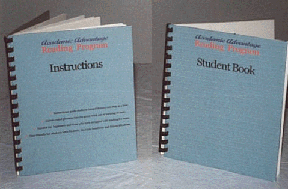 |
Who can benefit from this program?
ïŋ―ïŋ―ïŋ―ïŋ―ïŋ―This program can benefit anyone who is struggling to learn to read. There are many reasons why people have trouble reading. They may have missed a critical step in the learning process, or maybe the way they were taught didn't suit their learning style. They might also have Dyslexia, or perhaps Scotopic Sensitivity Syndrome. The Academic Advantage Reading Program has taken all these potential problems into consideration, and has been designed to help these students succeed at reading regardless of their age or present abilities.
The crazy English language:
ïŋ―ïŋ―ïŋ―ïŋ―ïŋ―The English language has so many rules and so many exceptions to its rules, that it is amazing that anyone ever masters it. Some letters have two or even three different sounds they can make. Sometimes letters can even be silent. Then there are the 'letter couples'; digraphs which use two letters to make one sound such as 'sh' and 'th', or diphthongs which are two vowels blended together such as 'ou' in 'house'. These use two letters to make one sound. There are also rules such as "when two vowels go walking, the first one does the talking". The Academic Advantage Reading Program introduces each of these concepts one at a time, minimizing the frustration for the student and instructor.
The solution:
ïŋ―ïŋ―ïŋ―ïŋ―ïŋ―Nearly every phonetic element of the English language is included with the program. The letters that seem to be missing in from the display board pictured below can be found at the bottom where they spell 'kite':
ïŋ―ïŋ―ïŋ―ïŋ―ïŋ―The Academic Advantage Reading Program uses small magnetized cards, each representing a different sound in the english language. The letter 'a' can make the 'short' sound as in 'at'; it can say it's own name as in 'ape', or it can sound like an 'o', as in 'ball'. By using a green 'a' in 'at', and an orange 'a' in 'ape', and a purple 'a' in 'ball', this program helps students make sense of the written word. The step-by-step approach introduces new letters and ideas one at a time, and ensures that the student has the skills to read the words in each step before they move on.

ïŋ―ïŋ―ïŋ―ïŋ―ïŋ―Notice how the 'i' in 'kite' is orange. This is because it says it's own name. If it made the more common 'short' sound - the sound it makes in 'if', the green 'i' would be used. The 'e' is hollow because it is silent.
ïŋ―ïŋ―ïŋ―ïŋ―ïŋ―People with Dyslexia often have difficulty discerning between the letters b, d, p, and q. By using a font in which these letters are not perfect mirror images of one another, this program points out ways to alleviate this problem. Scotopic Sensitivity Syndrome (S.S.S.) is a condition which makes black print on white paper very difficult to read. The colours used for the magnetized letters are designed to reduce this problem. These colours also have varying levels of darkness, so a person with colour blindness can tell them apart. As the program progresses, students are guided toward being able to read regular black print on white paper.

ïŋ―ïŋ―ïŋ―ïŋ―ïŋ―The following poem is an example of the sort of writing that is included for the students to practice their reading skills once they have learned the various sounds that each letter can make. The orange letters alert the reader to the fact that they do not make the most usual sound for that letter. The underlined 'letter couples' denote diphthongs and digraphs.
|
kangaroo zoo
we can shout out loud
|
On-Line Order Form For more information,
|